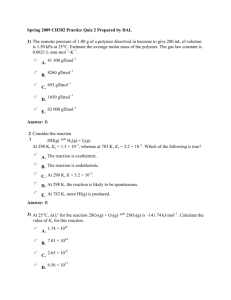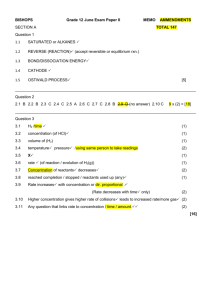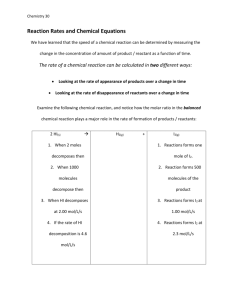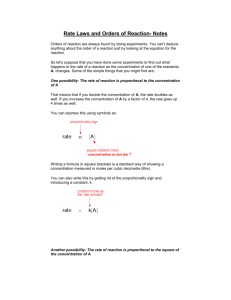Chapter 14: Chemical Kinetics
advertisement
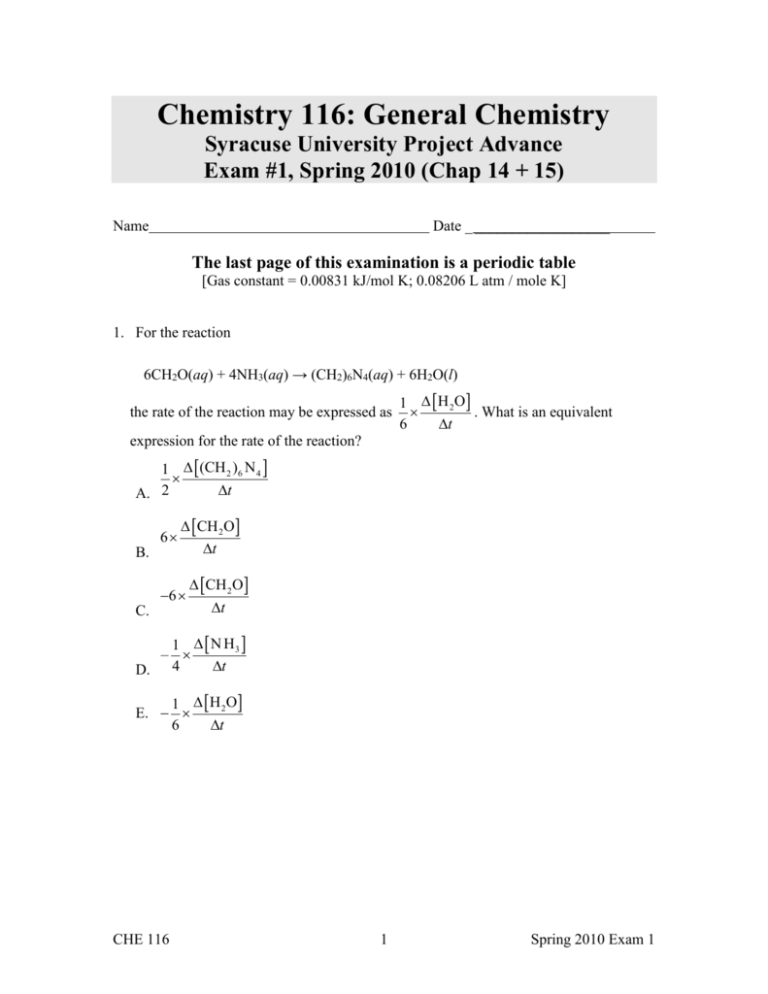
Chemistry 116: General Chemistry Syracuse University Project Advance Exam #1, Spring 2010 (Chap 14 + 15) Name Date _ __________________ The last page of this examination is a periodic table [Gas constant = 0.00831 kJ/mol K; 0.08206 L atm / mole K] 1. For the reaction 6CH2O(aq) + 4NH3(aq) → (CH2)6N4(aq) + 6H2O(l) the rate of the reaction may be expressed as 1 H 2O . What is an equivalent 6 t expression for the rate of the reaction? 1 (CH 2 )6 N 4 t A. 2 6 CH 2 O B. 6 C. t CH 2 O t 1 N H3 – t D. 4 1 H 2 O E. 6 t CHE 116 1 Spring 2010 Exam 1 2. For a certain second-order decomposition reaction, the rate is 0.44 mol/(L · s) when the concentration of the reactant is 0.37 mol/L. What is the rate constant for this reaction? A. B. C. D. E. 1.19 L/(mol · s) 0.44 L/(mol · s) 0.31 L/(mol · s) 0.84 L/(mol · s) 3.2 L/(mol · s) 3. For the reaction of the ammonium ion with nitrous acid, the net reaction is NH4+(aq) + HNO2(aq) → N2(g) + 2H2O(l) + H+(aq) If the initial concentration of nitrous acid is 1.00 M and, after 42.6 s has elapsed, the concentration of nitrous acid has fallen to 0.88 M, what is the average rate of the reaction over this time interval? (Average rate of change in M/s or [HNO2] / t) A. B. C. D. E. 0.021 M/s –0.021 M/s –0.0028 M/s 0.044 M/s 0.0028 M/s 4. For the hypothetical second-order reaction A → products, k = 0.189 M-1 s-1. If the initial concentration of A is 0.489 M, how long would it take for A to be 20.9% consumed? A. B. C. D. E. 1.24 s 2.86 s 41.0 s 8.28 s 10.8 s CHE 116 2 Spring 2010 Exam 1 5. The rate constants for the first-order decomposition of a compound are 5.50 × 10–4 s-1 at 39°C and 2.32 × 10–3 s-1 at 56°C. What is the value of the activation energy for this reaction? (R = 8.31 J/(mol · K)) A. B. C. D. E. 0.704 kJ/mol 72.1 kJ/mol 1.54 kJ/mol 0.667 kJ/mol 31.4 kJ/mol 6. Given the reaction and energy profile, A. B. C. D. Graph I Graph II Graph III Graph IV 7. Acetaldehyde decomposes at 750 K: CH3CHO → CO + CH4. The reaction is first order in acetaldehyde and the half-life of the reaction is found to be 530 seconds. What is the rate constant for the reaction at this temperature? A. B. C. D. E. -3 -1 1.3 x 10 s -3 -1 2.7 x 10 s -2 -1 1.8 x 10 s 2 -1 3.7 x 10 s 2 -1 7.6 x 10 s CHE 116 3 Spring 2010 Exam 1 8-11) The next four questions refer to the following data for a reaction written as 2A + 2B C + 2D. [A]0 0.10 M 0.20 M 0.10 M [B]0 0.10 M 0.10 M 0.20 M initial [C]/t 0.00030 M/s 0.00120 M/s 0.00030 M/s 8. What is the observed rate law for the reaction? A. B. C. D. E. rate = k[A] rate = k[A]2 rate = k[A][B] rate = k[A]2[B] rate = k[A]2[B]2 9. What are the proper units for the rate constant k? A. B. C. D. E. s-1 M s-1 M-1 s-1 M-2 s-1 M-3 s-1 10. What is the numerical value of k? A. B. C. D. E. 0.00030 0.00120 0.030 0.120 3.0 10-6 11. For the reaction with [A]0 = [B]0 = 0.10 M, how long would it take for [A] to reach 0.050 M? A. B. C. D. E. 5.7 s 23 s 83 s 333 s 2300 s CHE 116 4 Spring 2010 Exam 1 12. The observed rate law for the reaction A + 2B P was found to be rate = k[A][B]. Given that "I" represents an intermediate, which of the following mechanisms is consistent with the observed rate law? A. A + 2B P (one step) B. A + B I (slow) I + B P (fast) C. A + B I (fast) I + B P (slow) D. 2B I (slow) I + A P (fast) E. 2B I (fast) I + A P (slow) 13. Based on the plot below, what is the activation energy for A B? E, kJ/mol 40 30 B 20 10 A 0 A. B. C. D. E. -20 kJ/mol 10 kJ/mol 20 kJ/mol 30 kJ/mol 40 kJ/mol 14. What is the overall order of a reaction that has the following rate law? rate = [A]2[B]2[C] A. B. C. D. E. 2 3 4 5 6 CHE 116 5 Spring 2010 Exam 1 15. For the reaction IO3- + 5I- + 6H+ the rate of disappearance of I- at a particular time and concentration is 5.0 10-3 M s-1. What is the rate of appearance of I2? A. B. C. D. E. -5.0 10-3 M s-1 1.0 10-3 M s-1 6.0 10-3 M s-1 3.0 10-3 M s-1 5.0 10-3 M s-1 16. A pathway to the destruction of ozone in the upper atmosphere is O3(g) + NO(g) NO2(g) + O2(g) slow NO2(g) + O(g) NO(g) + O2(g) fast Which species is a catalyst? A. B. C. D. E. O3 NO NO2 O None of the above 17. For the decomposition of one mole of nitrosyl chloride, H = -200 kJ. NO(g) + O3(g) NO2(g) + O2(g) The activation energy for this reaction is 10 kJ. The activation energy for the reverse reaction is (a) (b) (c) (d) (e) CHE 116 10 kJ 190 kJ 200 kJ 210 kJ 250 kJ 6 Spring 2010 Exam 1 18. For the reaction between Q and Z, it is found that tripling the concentration of both reactants increases the rate by a factor of 27. If only the concentration of Z is tripled, the rate increases by a factor of 3. The experimental rate law is: (a) (b) (c) (d) (e) Rate = k[Q]1/2[Z] Rate = k[Q][Z]1/2 Rate = k[Q]2[Z] Rate = k[Q][Z] We cannot tell from the information given. 19. Which conditions will increase the rate of chemical reaction? (a) decreased temperature and decreased concentration of reactants? (b) decreased temperature and increased concentration of reactants? (c) increased temperature and decreased concentration of reactants? (d) increased temperature and increased concentration of reactants? (e) none of the above. 20. For the second order reaction 2A B + C with a rate constant of 1.2 x 10-2 L/mol s, calculate the half-life when the initial concentration is 0.30 mol/L. (a) (b) (c) (d) (e) 0.0011 s 25 s 58 s 4.6 m 7.2 m 21. Which of the following conditions characterizes a system in a state of chemical equilibrium? A. B. C. D. E. Concentrations of reactants and products are equal. Rate of forward reaction has dropped to zero. Reactants are being consumed at the same rate they are being produced. Reactant molecules no longer react with each other. Product concentrations are greater than reactant concentrations. CHE 116 7 Spring 2010 Exam 1 22. Which expression correctly describes the equilibrium constant Kc for the following reaction? 4 NH 3 (g) + 5 O 2 (g) A. K c B. K c 4 NO( g) + 6 H 2O (g) 4 N H3 5 O 2 4 NO 6 H 2O 4 NO 6 H 2O 4 N H3 5 O 2 NO H 2O N H3 O2 4 6 NO H 2O Kc 4 5 N H3 O2 4 5 N H3 O2 Kc 4 6 NO H2O C. K c D. E. 23. For the reaction given below, 2.00 mol of A and 3.00 mol of B are placed in a 6.00-L container. A(g) + 2B(g) C(g) At equilibrium, the concentration of A is 0.200 mol/L. What is the concentration of B at equilibrium? A. B. C. D. E. 0.200 mol/L 0.233 mol/L 0.300 mol/L 0.400 mol/L 0.500 mol/L 24. In which of the following equilibrium systems will the equilibrium shift to the left when the pressure of the system is increased? A. B. C. D. E. 3H2(g) + N2(g) 2SO2(g) + O2(g) H2(g) + Cl2(g) 4NH3(g) + 5O2(g) Ni(s) + 4CO(g) CHE 116 2NH3(g) 2SO3(g) 2HCl(g) 4NO2(g) + 6H2O(g) Ni(CO)4(g) 8 Spring 2010 Exam 1 25. Which is the correct equilibrium expression for the following reaction? 2Ag(s) + Cl2 A. Keq B. K eq C. K eq D. K eq 2AgCl(s) [AgCl] [Ag]2 [Cl2 ] [2AgCl] [2Ag][Cl2 ] [AgCl]2 [Ag]2 [Cl2 ] 1 [Cl2 ] E. Keq [Cl2] 26. Carbon tetrachloride reacts with oxygen at high temperature to produce chlorine and carbonyl chloride. 2CCl4(g) + O2(g) 2COCl2(g) + 2Cl2(g) Kc = 1.9 x 1019 What is Kc for the following reaction? COCl2(g) + Cl2(g) CCl4(g) + 1 O2(g) 2 A. B. C. D. E. 5.3 x 10-20 2.3 x 10-10 4.4 x 109 –1.9 x 1019 1.9 x 1010 27. For the following reaction at 127˚C, Kc = 49. What is Kp for the reaction? A(g) + B(s) A. B. C. D. E. C(g) + D(g) 4.5 10-2 1.5 49 1.6 103 5.3 104 CHE 116 9 Spring 2010 Exam 1 28. Addition of a catalyst to a reaction at equilibrium will A. increase the concentration of products and decrease the concentration of reactants. B. increase the concentration of reactants and decrease the concentration of products. C. increase the concentration of products and increase the concentration of reactants. D. have no effect on the concentrations of reactants and products. E. have different effects on the concentrations, depending on the catalyst used. 29. For the reaction CH4(g) + 2H2S(g) CS2(g) + 4H2(g) the value of Kc is 3.59 at 900°C. Predict the direction of the reaction, given the following initial set of concentrations: [CH4] = 1.26M, [H2S] = 1.32M, [CS2] = 1.43M, [H2] = 1.00M. (a) The reaction should proceed to the right (more products). (b) The reaction should proceed to the left ( more reactants). (c) The reaction is already at equilibrium. 30. SET UP ONLY Methanol, CH3OH(g), decomposes at 500K, with Kc = 0.0952, according to the following equation: CH3OH(g) CO(g) + 2H2(g) Suppose 1.0 mol of CH3OH(g) is placed in a 10.0L vessel at 500K and allowed to come to equilibrium. Calculate x, the number of moles of CO(g) in the vessel at equilibrium (SET-UP ONLY). (a) x(2x 2 ) 0.0952 1 x (b) (x)(2x)2 = 0.0952 (c) (10)(x)(2x) 2 0.0952 1 x (100)(x)(2x) 2 0.0952 (d) 1 x CHE 116 10 Spring 2010 Exam 1 x(2x 2 ) 0.0952 Answer E (e) 100(1 x) 31. Consider the reaction at equilibrium PCl3(g) + Cl2(g) <======> PCl5(g) If Cl2(g) is removed from an equilibrium mixture of these gases, (a) (b) (c) (d) the reaction shifts to the left (more reactants) the reaction shifts to the right (more product) the reaction is unaffected since H < 0 not enough information is provided to Answer the question EC1) The radioactive nuclide 63Ni decays by a first-order process via the emission of a beta particle. The 63Ni nuclide has a half-life of 100 years. How long will it take for 93% of 63Ni to decay? A. B. C. D. E. 10 years 1.8 years 170 years 4.5 years 380 years EC2) For the reaction A + B + C → products, the following initial-rate data were obtained. [A]0 (mol/L) [B]0 (mol/L) [C]0 (mol/L) 0.40 0.20 0.60 0.20 0.20 0.40 0.40 0.10 0.10 0.20 0.20 0.40 0.20 0.20 0.40 Initial Rate (mol/(L · s)) 0.0160 0.0080 0.0015 0.0005 0.0020 What are the reaction orders with respect to A, B, and C, respectively? CHE 116 11 Spring 2010 Exam 1 F. G. H. I. J. 1, 2, 0 0, 2, 1 0, 1, 1 1, 2, 1 1, 1, 1 EC3) The following set of data was obtained by the method of initial rates for the reaction: 2- 2HgCl2(aq) + C2O4 (aq) → 2Cl-(aq) + 2CO2(g) + Hg2Cl2(s) What is the value of the rate constant, k? (Hint: Solve for rate law first, then plug in from table to solve for k) [HgCl2] (M) 0.10 0.10 0.20 A. B. C. D. E. [C2O42-] (M) 0.10 0.20 0.20 Rate (M/s) 1.3 × 10–7 5.2 × 10–7 1.0 × 10–6 -8 1.4 × 10 M-2∙s-1 -7 1.3 × 10 M-2∙s-1 -7 2.6 × 10 M-2∙s-1 -5 1.4 × 10 M-2∙s-1 -4 1.3 × 10 M-2∙s-1 EC4) Phosphorus pentachloride, PCl5, decomposes when heated according to the following equation: PCl5(g) <======> PCl3(g) + Cl2(g) If the initial concentration of PCl5 is 1.00 mol/L, what is the equilibrium concentration of PCl3 at 160° C if the equilibrium constant (Kc) is 0.0211 at 160° C? (a) (b) (c) (d) (e) CHE 116 0.135 M 0.156 M 0.844 M 0.865 M 0.932 M 12 Spring 2010 Exam 1 CHE 116 13 Spring 2010 Exam 1

